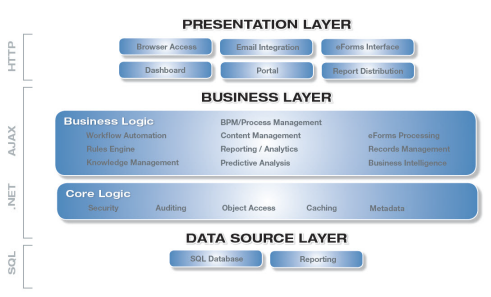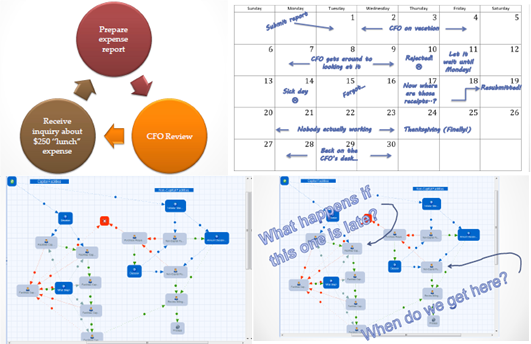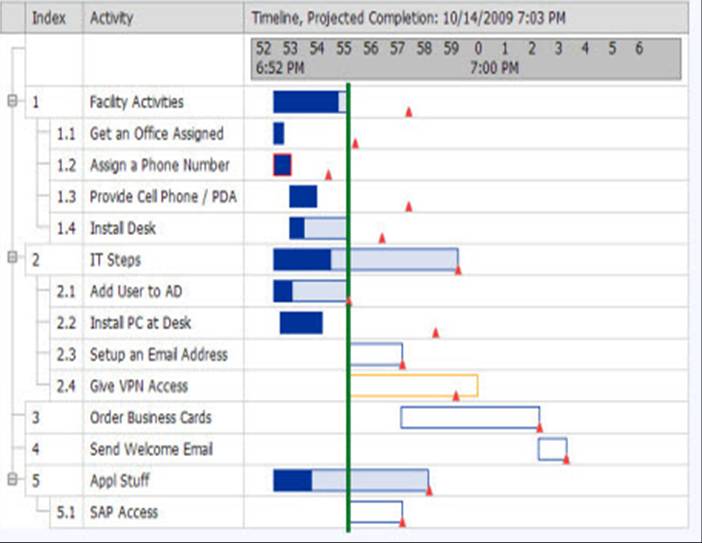Adding the Time dimension to BPM
For those of you who have been involved in mapping the process of an organisation, you will know that often there is a series time element involved in how the process works and this can be difficult to model. I had a briefing from Scott Menter, VP of Business Solutions for BP Logix, in which he explained how his company had come up with a solution to this issue.
BP Logix was initially founded in 1995. They are a privately-held company with their headquarters in San Diego. They started specialising in BPMS in 2004, focusing on providing a solution that incorporates collaboration and managing information flow at its core. In response to customer needs, they subsequently began to provide and manage electronic forms, then to address workflow, review and approval of their documents. In addition to its internal product development organisation, BP Logix’ Customer Advisory Board, made up of representatives from Bechtel, NIMH, Johnson & Johnson, Starwood Hotels & Resorts and Vulcan Materials, provide a key voice in product direction. What differentiates BP Logix is that they are the first BPMS provider that I have come across who has addressed the needs of time-based or activity-focused processes.
Why is time important? Menter explained this by talking about his dog, Bella. She knows when she wants to go for a walk and it is always at the same time of the day. Similarly she will whine if she doesn’t get her food at the right time. So time is important. Menter added, “Time is the key to why we implement BPM in the first place.”
Before we take a look at how BP Logix Process Director deals with time, it is important to understand that the product is otherwise a standard BPMS. Process Director provides integrated reporting, workflow software, eForms, content management, dashboard, portal and application integration. There is support for standard BPMN style modelling of process. It is built on .NET Framework, has multi-language capability and supports international localisation. There is support for customisation via an SDK. As can be seen in Figure 1, the product can be deployed in a 3-tier data access environment, providing a separation between client access, business logic and database access. The client browser (tier 1) uses HTTP/HTML and AJAX to communicate with the server. The server business layer (tier 2) uses ADO.NET to access the database repository. The database can be either Microsoft SQL Server or Oracle. Process Director provides built-in integration with many third-party and in-house applications and databases:
- SQL-compliant databases
- Email systems
- Scanners and document imaging software
- Windows file systems
- ERP and CRM applications
- Mobile devices
- Web portals
- Single Sign-On (SSO) products
- Web services

Figure 1: BP Logix Product Architecture (Source: BP Logix, Inc.)
BPM solutions have focused on getting the quality and governance of business processes. But time is a critical element of the planning, management and improvement of business processes. Time allows business users to gain additional control over their processes and creates the opportunity to predict how later stages in the process will be affected by changes introduced in the earlier stages. This predictive capability allows process owners to examine “what-if” scenarios, enabling them to predict the impact of an anticipated or hypothetical delay in a given process instance. BP Logix views this approach as offering organisations more insight than before into their processes, providing the earliest possible notification of potential delays.

Figure 2: The Time Issue (Source: BP Logix, Inc.)
To support this new predictive concept, BP Logix has introduced a patented technology that fuses project management methodologies with BPM, called Process Timelines. Business users design Process Timelines by answering two questions as they add each step to the process: What must complete before this step can begin – the dependency question; and how long will this step take to complete – the duration question. Each activity will begin as soon as its prerequisites, if any, are complete.

Figure 3: A Process Timeline (Source: BP Logix, Inc.)
For those of us used to using MS Project or any other Project definition tool that supports Gantt charts this seems quite logical. I have myself, in the past, used MS Project to show dependencies between processes as well as parallelism. What is neat about the BP Logix solution is that they have integrated traditional process modelling with Process Timelines within Process Director. A single Process Timeline activity can contain an entire traditional workflow, enabling several workflows to be strung together to form a more complex, yet easily manageable process.
Reports and information can be displayed in real time or scheduled for distribution. Report distribution allows scheduled reports to be emailed to recipients as PDF documents. A web-based dashboard interface is also available. The reporting information can be exported to various formats, including Microsoft Excel or any SQL compliant report writer such as Crystal Reports.
In August 2013, BP Logix released version 3 of Process Director. The key new facility is the integration with social media. Version 3.0 enables organisations to provide services to customers, partners and suppliers outside their organisation through cloud-based/federated identity integration. Customers can participate in workflows as authenticated users, taking advantage of their accounts within Facebook, Twitter and Google. Corporate partners and suppliers can log in using ADFS, SAML and OAuth. Popular network and cloud-based services can be integrated directly into business processes. Examples of ways to use this integration capability include the following:
- Drive workflow behaviour from social media events including a tweet or Facebook status update
- Respond to customers via Twitter (tweet, RT, DM, reply)
- Manage Facebook campaigns (likes/unlikes, comments)
This integration provides the ability for an organisation to engage with their customers by reaching out to them wherever they are, as well as embrace their customers by letting them participate directly in an organisation’s business processes and to do this by extending through the cloud into your organisation as well as your stakeholders.
At the same time Process Director/Cloud Edition has been named one of KMWorld’s Trend-Setting Products for 2013. Hugh McKellar, KMWorld editor-in-chief said, “Process Director/Cloud Edition was selected by the panel because it continues to demonstrate thoughtful, well-reasoned innovation and execution for the most important constituency of them all: the customer.”
If you are looking at managing your business process, then Process Director is certainly a product that should be on your shortlist. I was impressed with its ease of use as well as its support for time-based processes. The latest version with its ability to integrate social media activities into a business process is another great feature.
